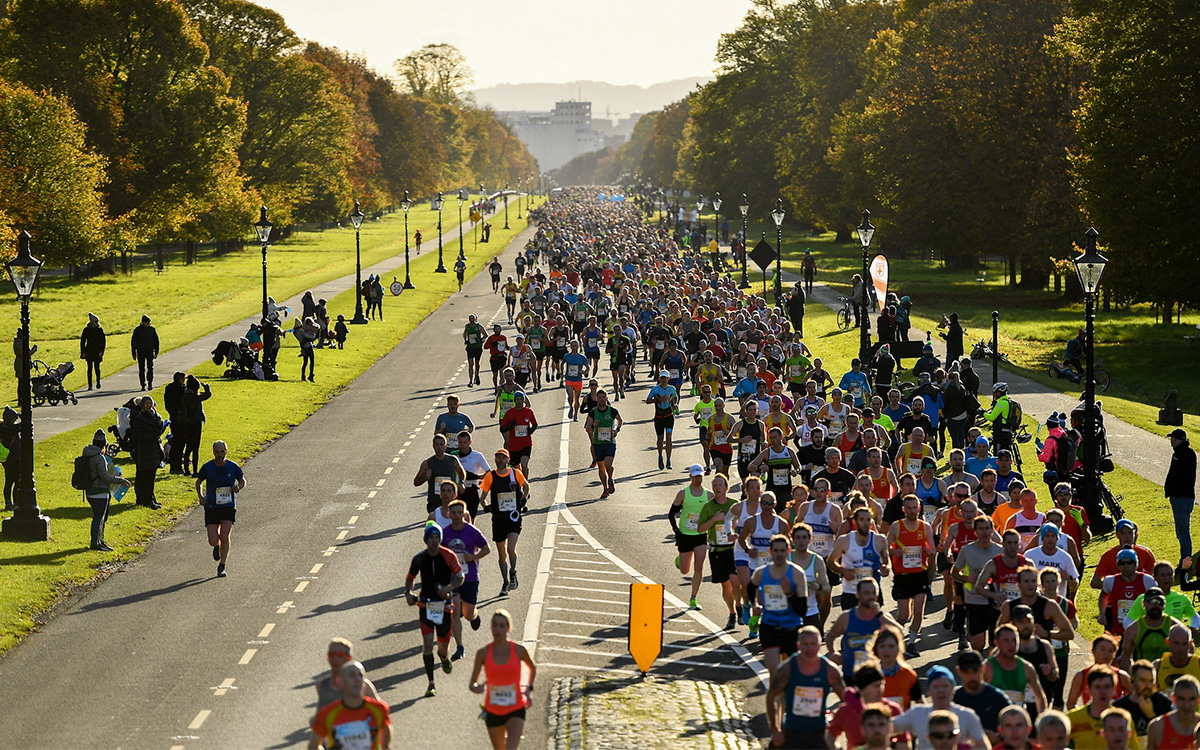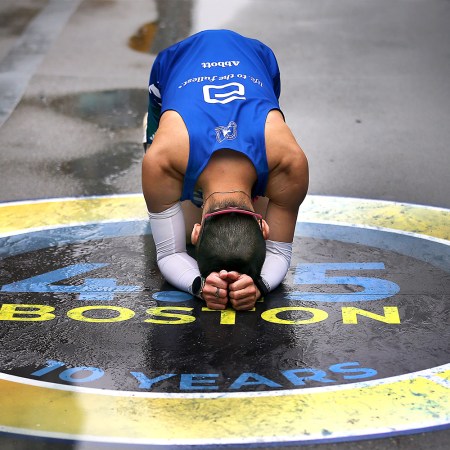Yesterday morning, around 53,000 men and women got up at 5 a.m. and lugged themselves down to Staten Island to complete the world’s most popular marathon.
In the months leading up to this year’s edition, the New York City Marathon plastered the city’s buses and subway stops with ads bearing a banal slogan: “It will MOVE you.” I rolled my eyes the first couple of times I read it. But around 1:00 in the afternoon on 1st Ave. yesterday, wedged between a Midwestern couple who was anxious they might miss their son and a crew of cow-belling Spaniards eager to cheer on literally whomever rolled by, I finally got it.
People showing up to support loved ones and strangers alike as they run for hours on end to raise millions of dollars for charity is worthy of all marketing hyperbole. From the sixth-timers down to the bucket-list-checkers, it’s a culmination of months of work. I shared a couple pints of Guinness with friends of mine who finished, and their loopy grins said it all.
Not everyone makes it to the starting line, though, let alone the finish. According to the American College of Sports Medicine, more than half of first-time marathoners drop out before their race. That’s because the only thing more difficult than running a marathon is the training it necessitates, often at least 12 weeks of mileage building, topping out at multiple 20-milers. This unexpected overload of work is hell below the knees; at the very least it’ll induce regular post-exercise muscle soreness (POMS), and at its worst, could lead to a serious stress fracture.
Considering the relatively older age of marathon runners (38.7 years old, on average), it’s paramount that they approach their training with a proactive attitude towards injury. All runners deserve their proverbial 1st Ave. race day cheers, and to make sure they get them, their preparation has to extend beyond adhering to an online mileage calendar. A proper marathon plan these days should include cross-training, value smart choices in the kitchen, pack a ton of sleep, and value mental health, too. But don’t just take it from us. We reached out to a panel of 10 experts, from ultra-runners to the co-founder of the Miami Marathon to a Marvel superhero dietician, who offered up their best hacks and habits for making it to the starting line in one piece.
Spoiler alert: water is your best friend, it’s time to start lifting, and you might not need to fork over cash for an expensive massage toy.
1. Running a marathon is a full-body exercise. Train accordingly.
“Cross training at least once a week will help you stay healthy. The body is a complex, interconnected system; all aspects of it need to be strengthened. Working the stability muscles in the hips, knees, ankles, and feet will help you maintain proper running form over long distances. Strengthening the core, back, and shoulders will aid in posture and breathing. Running alone cannot adequately prepare the body for marathons. I am a big proponent of vinyasa yoga at least once a week, which provides strength and conditioning of the whole body and also keeps the body limber.” –Keith Wallace, Running Coach at Road Runners Club of America
2. Take your hydration and diet seriously
“People often forget how critical water intake is. Water comprises 70% of the human body and should be the most important nutrient for everyday functioning. Without water, basic human functions would not be able to take place. It enables nutrients from the food we eat to get into our cells, helps remove waste and toxins from the body, balances and manages electrolytes, and regulates the body’s temperature. Drinking water first thing in the morning is a great way to jumpstart your metabolism and rehydrate your body after a night of rest. This will help you feel more energized and put you on the right track for success by getting a head start on your daily H2O goal. Approximately one ounce for every pound you weigh is needed for proper hydration.
Meanwhile, for dinner: prioritize protein and vegetables. Your body will utilize the protein to help with recovery while you sleep. Aim for fatty fish like salmon, sea bass, black cod or Arctic char. Fish has a lot of anti-inflammatory and fat-burning benefits when eaten at night; this is when your body has time to rest and repair your muscle tissue. Using high-fat fish as a dinner choice can lead to deeper sleep, increased growth hormone release and reduction of inflammation.” –Dr. Philip Goglia, Nutritionist for Marvel Superheroes and Co-Founder of G-Plans
3. Mix in low-impact endurance training
“Mix up your training: biking and swimming can still help you build endurance without harming your knees or causing pain in those body parts that are experiencing the constant pounding from running. And for long runs: bring something along to refuel you. I always feel better when I have something at the halfway point of any run longer than 10 miles. I prefer the chocolate-flavored gels, and like to run with a water backpack. It’s the easiest way to make sure I’m getting enough water.” –Alison Walsh, Six-Time Marathon Finisher
4. Always be in recovery mode
“Get DIY: The best recovery toys for a runner during the last few weeks don’t need to be expensive or complicated. Tennis balls, golf balls and even wooden baking rollers do the trick for addressing sore areas. Don’t wait until the end of the day to use that stuff on the body; try to sneak a few minutes in during your work day. Also, after a shower use your damp towel as a ‘rope’ to stretch your calf muscles out. Lay out on your back and raise one leg at a time while pulling down on the towel wrapped around your forefoot. Lightly tug at it in various directions. You can also push against it as if pressing on the accelerator in your car. Make sure to ice, too. It’s especially helpful for packing in extra miles during the last few weeks. Grab your garbage can, use a clean liner or two and fill it with a few 10 pound bags of ice. Fill it with some water from your hose about halfway and slide in to the can. Try to stay in there for at least 10 minutes.” –Frankie Ruiz, Co-Founder and Chief Running Officer of Life Time’s Miami Marathon
5. And the first step of recovery is replenishing nutrients
“It’s important to get nutrition within 30 minutes after a hard workout or more than an hour of running. I always make sure to drink a smoothie as soon as I get in the door, and use Vega protein and glutamine in them to help speed up recovery. I’ve also noticed collagen can help prevent ashiness in the joints.” –Whitney Heins, Founder of The Mother Runners
6. Don’t sacrifice sleep
“People rarely get enough sleep during their training. Sleep is paramount to recovery; your body literally repairs itself during deep sleep. It’s not worth sacrificing sleep for waking up early and getting long runs in. This focus on gaining mileage just increase risks for injury, especially if there also isn’t an emphasis on strength training.” –Rena Eleázar, Board Certified Sports Physical Therapist, owner of Match Fit Performance
7. Worried about an ailment or chronic condition? There are probably ways around it.
“As a Type 1 Diabetic, I needed to figure out a ‘hack’ to be able to run long distances while maintaining my blood sugar levels. At first, I strategically planned my running routes near my house, in case my blood sugar levels were significantly dropping. Then, after reading an article by Dave Holmes on the Beyond Type 1 website, I learned that sprinting can actually stabilize your blood sugar. So, my second hack was to pick up my speed to try to stabilize my blood sugar throughout my training.” -Nate Checketts, CEO and Founder of Rhone
8. Mind your mental health
“Remember your mental health when training for a marathon! Running up to 50 miles a week is as taxing mentally as it is physically. To keep my mind as healthy as my body, I make sure to curate playlists of different genres of music, along fun podcasts that I’ll actually look forward to listening to on my three-four hour training runs. I’d also recommend finding a way to make your post-run more relaxing. Find your local rec pool or hot tub and take a quick plunge or swim; it’s be the perfect way for your body to stretch out those muscles and joints in a different capacity.” –Ashley Reinke-Hawk, Miss Arizona 2018, Five-time LA Marathon finisher
9. Rest days are just as important as run days
“Overtraining is a common problem for most devoted athletes, especially leading into a major event like a marathon. Schedule one day of complete rest each week to allow your body time to heal and strengthen, which will help repair the micro tears from exerting muscles. And when you are training, introduce a strength element. Find two to three days a week to focus on your hamstrings, glutes and rhomboids — the posterior chain. This will help avoid muscle imbalances and reduce problems like lower back or knee pain.” –Harley Pasternak, Trainer to Ariana Grande and Lady Gaga
10. Treat yourself
“Massage was a game changer for me over the last year and a half. I found an incredible massage therapist who specializes in biomechanics and saw him once or twice a month. My aches and pains were minimal, my range of motion is the best it’s ever been, and my entire body felt amazing during last year’s Mount Desert Marathon, which includes 34 miles of Idaho mountains. A more affordable alternative would be committing to foam rolling, and regularly attending a gentle yoga class.” –Michelle Abbey, RDN, Ultra-Runner
Whether you’re looking to get into shape, or just get out of a funk, The Charge has got you covered. Sign up for our new wellness newsletter today.
























